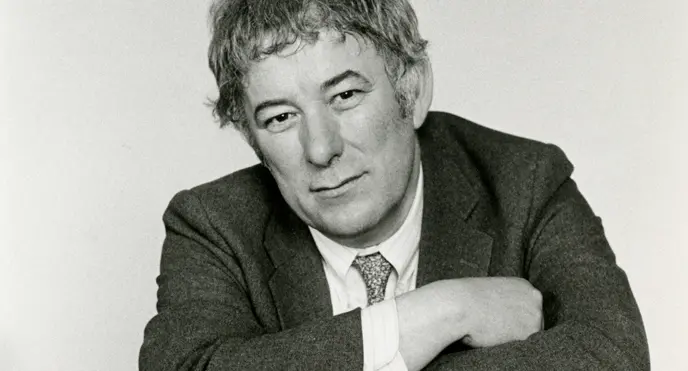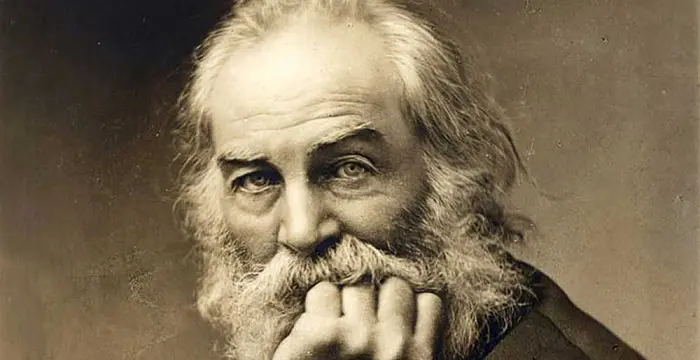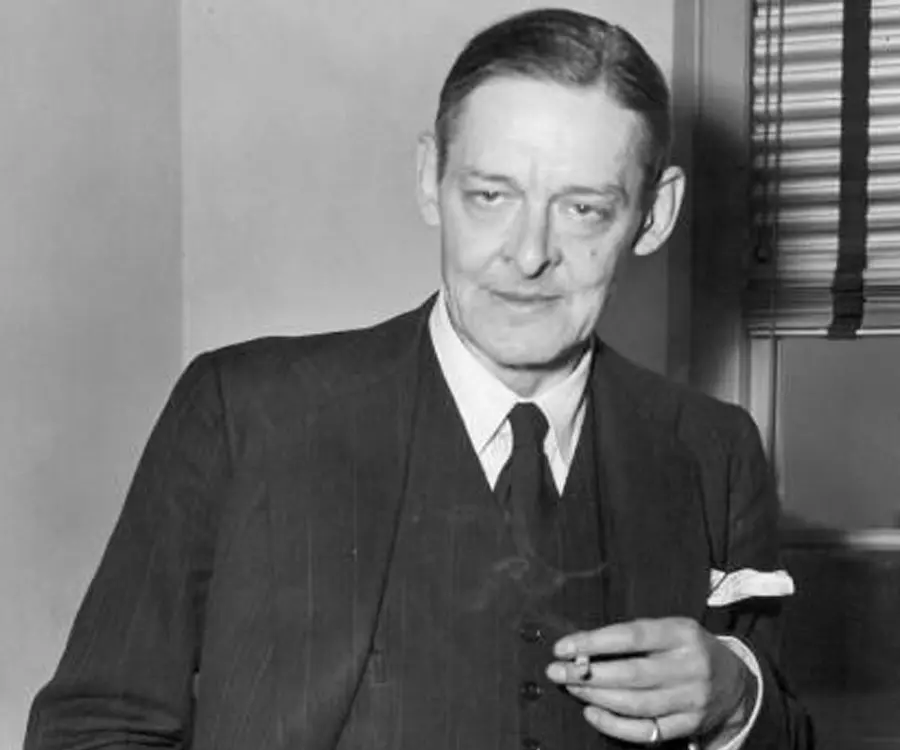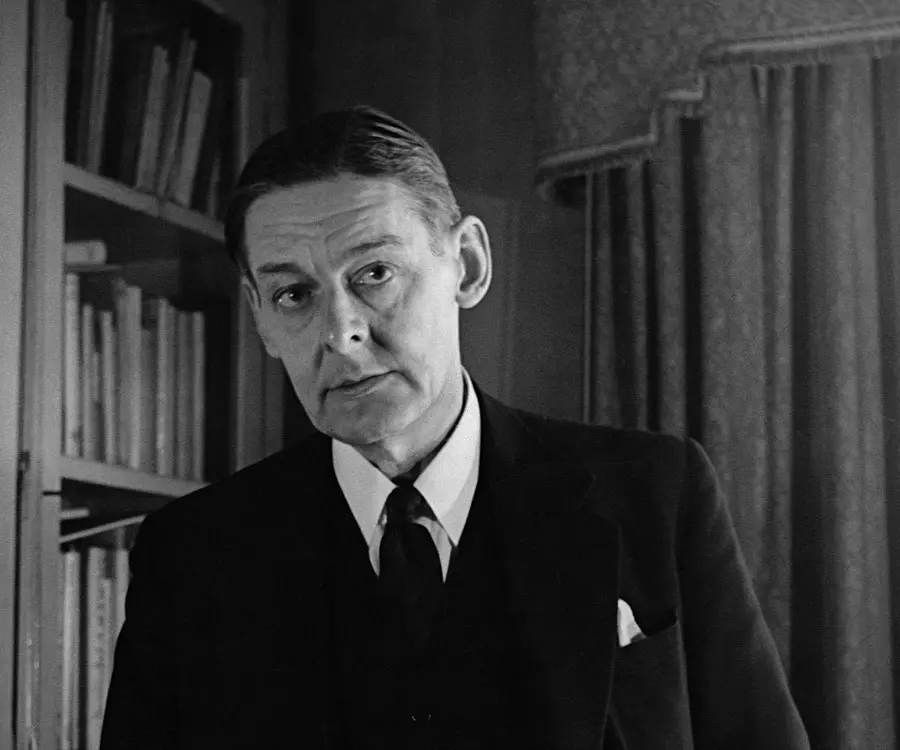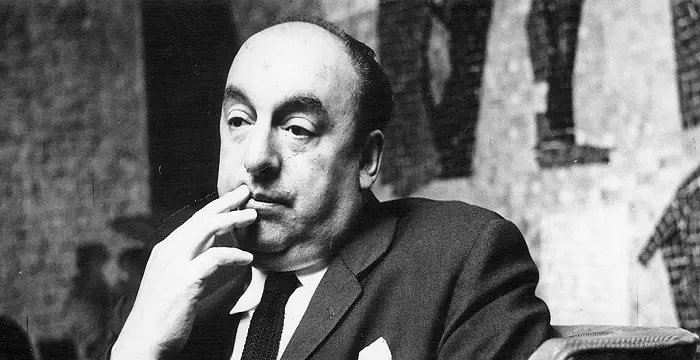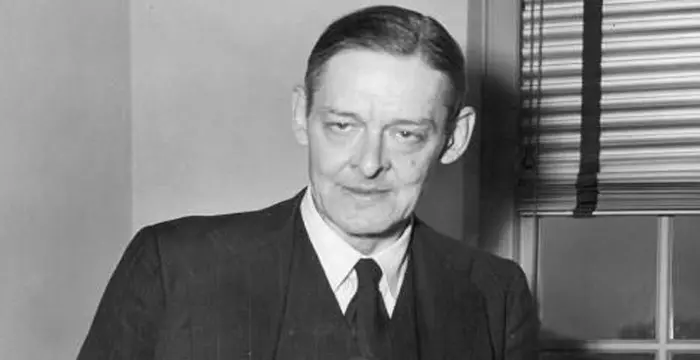
T. S. Eliot - Nobel Laureates In Literature, Timeline and Childhood
T. S. Eliot's Personal Details
Thomas Stearns Eliot, better known as T.S
| Information | Detail |
|---|---|
| Birthday | September 26, 1888 |
| Died on | January 4, 1965 |
| Nationality | American |
| Famous | Nobel Laureates In Literature, Harvard University, Writers, Poets |
| City/State | Missouri |
| Spouses | Valerie Eliot (m. 1957–1965), Vivienne Haigh-Wood (1915–1947) |
| Siblings | Tom |
| Known as | Thomas Stearns Eliot, Eliot, T. S. Eliot, Thomas Eliot |
| Childrens | None |
| Universities |
|
| Notable Alumnis |
|
| Birth Place | St. Louis, Missouri, United States |
| Height | 180 |
| Gender | Male |
| Father | Henry Ware Eliot |
| Mother | Charlotte Champe Stearns |
| Sun Sign | Libra |
| Born in | St. Louis, Missouri, United States |
| Famous as | Poet |
| Died at Age | 76 |
// Famous Poets
Charles Bukowski
Charles Bukowski was a German-born American novelist, short story writer and poet. With this biography, learn in details about his childhood, life, works, career and timeline
Seamus Heaney
Nobel Laureate Seamus Heaney was an Irish poet, playwright and translator. Know about his profile, childhood, life and timeline in the biography below.
Walt Whitman
Walt Whitman was an American poet, journalist and humanist. Read this brief biography to find more on his life & timeline.
T. S. Eliot's photo
Who is T. S. Eliot?
Thomas Stearns Eliot, better known as T.S. Eliot, was an American-English poet, playwright, literary critic, and editor. A leader of the Modernist movement in poetry, his works influenced many established British poets of that day. Born in the United States America in late nineteenth century, he was infatuated with literature from his early childhood, inheriting his mother’s literally skill, writing his first poetry at the age of fourteen. It was not until he was seventeen that his literary talent began to bloom and at Harvard, where he went for his undergraduate studies, he made quite an impression by his regular contribution to the Harvard Advocate. But, he actually began to flourish when he shifted to England at the age of twenty-six, where his first published book, ‘Prufrock and Other Observations’, made him famous overnight. However, for a writer of his stature, he had produced comparatively small number of poems. That is because he wanted each of them to be perfect. For his contribution to poetry, he received the Nobel Prize in Literature at the age of sixty.
// Famous Harvard University
Bertil Gotthard Ohlin
Bertil Gotthard Ohlin was a famous Swedish economist. This biography profiles his childhood, family life & achievements.
Xi Mingze
Xi Mingze is the daughter of Chinese Leader Xi Jinping, Check out this biography to know about her birthday, childhood, family life, achievements and fun facts about her.
Susan Sontag
Susan Sontag is an American critical essayist, cultural analyst, novelist, political activist, filmmaker and playwright of international repute. Read on to find out more about her childhood, career, profile and timeline.
Childhood & Early Life
Thomas Stearns Eliot was born on 26 September 1888, in St. Louis, Missouri into a distinguished family, having their roots both in Old and New England. Named after his maternal grandfather, Thomas Sterns, he was mostly called Tom by his family and friends.
His father, Henry Ware Eliot, was an industrialist and philanthropist. He served as the Secretary at the Hydraulic-Press Brick Company before becoming its President. He was also a Member of the Board of Directors at Washington University, co-founded by his father William Greenleaf Eliot.
His mother, Charlotte Champe Stearns Eliot, was a school teacher and poet. She loved to dramatize those events from history, which reflected the struggles of men, dying for their faith. Later in life, she took part in social reforms, providing a house of detention for juveniles.
Thomas was the youngest of his parents’ seven children, having five sisters and one brother. Among them, Theodora Sterling Eliot, three years his senior, died in infancy. His surviving siblings were Ada (Eliot) Sheffield, Margaret Dawes Eliot, Charlotte (Eliot) Smith, Marian Cushing Eliot, and Henry Ware Eliot, Jr.
In his childhood, Thomas suffered from congenital double inguinal hernia, which prevented him from participating in many childhood activities. Consequently, he had few friends and spent most of his time, reading stories about Wild West and savages. He was especially fond of ‘The Adventures of Tom Sawyer’.
In 1898, Thomas Elliot entered Smith Academy, founded by his grandfather William Greenleaf Eliot. Here, among other subjects, he studied Latin, Ancient Greek, French and German.
His first poems, written at the age of fourteen, were inspired by Edward Fitzgerald's Rubaiyat of Omar Khayyam. However, they turned out to be rather gloomy and so he destroyed them.
In 1905, T.S. Eliot graduated from school and entered Milton Academy in Massachusetts for a preparatory year. This was also the time when his literary talent started blooming. His oldest poem, which survives in manuscript form, was written in April 1905. It was later revised and printed in The Harvard Advocate as ‘Song’.
Before that, in February 1905, he had another poem, ‘A Fable For Feasters’, published in the Smith Academy Record. Also in the same year, he had three stories ,‘Birds of Prey’, ‘A Tale of a Whale’ and ‘The Man Who Was King’, published.
In 1906, he was enrolled at the Harvard University with philosophy. During his university years, he was greatly influenced by George Santayana, the philosopher and poet, and Irving Babbitt, the critic. Continuing to write, he made good impression by contributing regularly to Harvard Advocate.
T.S. Eliot covered his undergraduate course in three years, instead of four years and received his Bachelor of Arts degree in 1909. Thereafter, for one year, he worked as a philosophy assistant at Harvard, before moving to France in 1910.
In 1910-1911, he studied philosophy at the Sorbonne University in Paris, attending lectures by Henri Bergson. He also studied poetry with Henri Alban-Fournier, John Webster and John Donne, and Jules Laforgue. It was during this time when Eliot started developing his own style.
In 1911, he returned to Harvard, where he studied Indian philosophy and Sanskrit until 1914. Thereafter, on being awarded a scholarship to Merton College, Oxford, he left for England.
On the way to England, he stopped at Marburg, Germany. He had planned to take up a summer program there; but as the First World War broke out in the middle of 1914, he abandoned the idea and left for Oxford.
In England
Although T.S. Eliot settled down in Oxford he was never fond of university towns, finding such places dull. Therefore, he often escaped to London, where he met many poets and writers. Chief among them was Ezra Pound, who was already established as a poet in London’s literary circle. .
Ezra Pound was quick to recognize the budding talent in Eliot and introduced him to many poets, writers, artists and intellectuals in London. He also helped him to publish his works.
In 1915, Eliot left Merton and started teaching French and Latin in Highgate Junior School in London. To earn extra money, he took evening extension classes at Birkbeck, University of London, where he taught English. Writing reviews was another source of his income.
Also in 1915, he had ‘The Love Song of J. Alfred Prufrock’ published in ‘Poetry’. It was not only the first poem of this period, but also his first major work. Radical in nature, it represented a break from the immediate past.
All along T.S. Eliot continued working on his doctoral dissertation for Harvard, ‘Knowledge and Experience in the Philosophy of F. H. Bradley’. He completed it in 1916 and although it was accepted, because of the ongoing war, he could not travel to the USA to defend it.
In 1917, he was employed as a clerk at the Lloyds Bank, London, a position he would hold until 1925. In the same year, he replaced Richard Aldington as the literally editor of Egoist, a London literally magazine, which mostly published modernist works.
Also in 1917, he had his first book of poems, ‘Prufrock and Other Observations’ published. The collection received good reviews and established him as one of the leading poets of the day.
Eliot remained with Egoist until 1919. One of his seminal works, ‘Tradition and the Individual Talent’, was first published in 1919 in the Egoist, later finding place in his first book on criticism, ‘Sacred Wood’ (1920). It is possible that he had started working on ‘West Land’ by now.
In May 1921, in a letter to John Quinn, a patron of modernism, Eliot had said that he had a long poem in mind. He also said that he had put it partly on paper, but now wanted to finish it.
In the autumn of 1921, on leave from his bank due to some kind of nervous breakdown, Elliot traveled to Margate in Kent. Putting up in Cliftonville, he concentrated on finishing the ‘West Land’. However, he took quite a few months to complete this 434 line poem.
’West Land’ was first published in England in the opening issue of The Criterion, a literary journal Eliot founded in October 1922 with the intention of providing standard literally review. Very soon, it became immensely popular and Eliot remained its editor until it closed down in 1939.
In 1925, Eliot left Lloyd Bank to join Faber and Gwyer, a publishing firm, which later became Faber and Faber, remaining there for the rest of his career. Eventually, he became one of its directors. Also in 1925, he had another of his poems, ‘The Hollow Men’ published.
In 1926, he tried his hand at writing a verse drama; but was able to complete only the first scene. The second scene was published a year later in 1927. In early 1930s, they were compiled, ‘Sweeney Agonistes: Fragments of an Aristophanic Melodrama’.
An Anglican & British Citizen
Born Unitarian, T.S. Eliot converted to Anglicanism on 29 June 1927. Next in November 1927, he took up British citizenship. The move made him feel closer to English culture. Eventually, he became a warden of Saint Stephen's, his parish church and a life member of the Society of King Charles the Martyr.
In April 1930, he had his second long poem, ‘Ash Wednesday’ published. Often referred as ‘Eliot’s conversion poem’, it deals with the struggle that takes place when a person moves from spiritual barrenness towards religious fulfillment.
His next major work, ‘Old Possum's Book of Practical Cats’ was published in 1939. It consisted of number of whimsical poems, written over the decade. Meanwhile, he continued to produce significant number of verse dramas as well as literary criticism.
In the early 1960s, T.S. Eliot started working as an editor for the Wesleyan University Press. Although his health had started deteriorating by then he continued to seek new European poets for publication.
Major Works
Among all his works, Eliot considered his 1943 book, ‘Four Quarters’, his best. Although it consists of four old poems, ‘Burnt Norton’ (1936), ‘East Coker’ (1940), ‘The Dry Salvages’ (1941)and ‘Little Gidding’ (1942), most scholars refer to it as his great last work. Although written individually, all of them have common theme, which is man’s relationship with time, universe and God. To make his point, he had imported philosophical works and cultural traditions from various eastern as well as western religions and blended them with Anglo-Catholicism.
Awards & Achievements
In 1948, Eliot received the Nobel Prize in Literature "for his outstanding, pioneer contribution to present-day poetry".
Other major awards received by him were Hanseatic Goethe Prize (of Hamburg) in 1955 and Dante Medal (of Florence) in 1959.
In 1948, Eliot was awarded with Order of Merit by the British monarch.
In 1964, he received Presidential Medal of Freedom from United States of America.
He received Officier de la Legion d'Honneur (1951) and Commandeur de l'Ordre des Arts et des Lettres (1960) from France.
He received three Tony Awards. In 1950, he received the award in the Best Play category for his play ‘The Cocktail Party’, produced at the Broadway. Next in 1983, he received two Tony Awards for his poems used in the musical ‘Cats’.
He had received thirteen honorary doctorates from established universities, which included Harvard, Oxford, Cambridge and Sorbonne.
Personal Life & Legacy
On 26 June 1915, T.S. Eliot married Vivienne Haigh-Wood, a Cambridge governess and a writer. Most probably, they got married so that he could remain in England and therefore, none of them were happy in this marriage. Moreover, Vivienne’s long list of illness, coupled with mental instability, made him increasingly detached.
The couple was formally separated in 1933. In 1938, before the divorce proceedings could start, Vivienne’s brother committed her to a lunatic asylum, where she remained until her death in 1947. Although she legally remained his wife, Eliot never visited her.
From 1938 to 1957, he had a relationship with Mary Trevelyan, at that time, a warden of Student Movement House, University of London. Although Mary wanted to marry him for some reason it never took place.
On 10 January, 1957, Eliot married Esmé Valerie Fletcher, his secretary at Faber and Faber in a private ceremony. The couple remained married till his death in 1965. After his death, she dedicated herself in preserving his legacy, editing and adding notes to ‘The Letters of T. S. Eliot’.
On 4 January, 1965, Eliot died of emphysema at his home in London. His mortal remain was cremated at Golders Green Crematorium in London. Later, his ashes were taken to East Coker, his ancestral village in Somerset, and buried at the St Michael and All Angels' Church.
At the Church, a wall plaque with a quotation from his poem ‘East Coker’ has been erected. It says, "In my beginning is my end. In my end is my beginning”.
In 1967, a large stone, inscribed with his dates and a quotation from his poem "Little Gidding", was placed in his memory in the Poets' Corner in the Westminster Abbey, London. It says, "the communication / of the dead is tongued with fire beyond / the language of the living”.
// Famous Nobel Laureates In Literature
Seamus Heaney
Nobel Laureate Seamus Heaney was an Irish poet, playwright and translator. Know about his profile, childhood, life and timeline in the biography below.
Jean-Paul Sartre
Jean-Paul Sartre was a great existentialist philosopher of the 20th century. Check out this biography to know about his childhood, family life, achievements and other facts related to his life.
Pablo Neruda
Pablo Neruda was a Chilean poet, politician and Nobel laureate. Go through this biography to learn more about his profile, childhood, life and timeline.
T. S. Eliot's awards
| Year | Name | Award |
|---|---|---|
Other | ||
| 0 | 1948 - Nobel Prize in Literature | |
| 0 | 1948 - Order of Merit | |
T. S. Eliot biography timelines
- // 26th Sep 1888Thomas Stearns Eliot was born on 26 September 1888, in St. Louis, Missouri into a distinguished family, having their roots both in Old and New England. Named after his maternal grandfather, Thomas Sterns, he was mostly called Tom by his family and friends.
- // 1898In 1898, Thomas Elliot entered Smith Academy, founded by his grandfather William Greenleaf Eliot. Here, among other subjects, he studied Latin, Ancient Greek, French and German.
- // Feb 1905Before that, in February 1905, he had another poem, ‘A Fable For Feasters’, published in the Smith Academy Record. Also in the same year, he had three stories ,‘Birds of Prey’, ‘A Tale of a Whale’ and ‘The Man Who Was King’, published.
- // Apr 1905In 1905, T.S. Eliot graduated from school and entered Milton Academy in Massachusetts for a preparatory year. This was also the time when his literary talent started blooming. His oldest poem, which survives in manuscript form, was written in April 1905. It was later revised and printed in The Harvard Advocate as ‘Song’.
- // 1906In 1906, he was enrolled at the Harvard University with philosophy. During his university years, he was greatly influenced by George Santayana, the philosopher and poet, and Irving Babbitt, the critic. Continuing to write, he made good impression by contributing regularly to Harvard Advocate.
- // 1909 To 1910T.S. Eliot covered his undergraduate course in three years, instead of four years and received his Bachelor of Arts degree in 1909. Thereafter, for one year, he worked as a philosophy assistant at Harvard, before moving to France in 1910.
- // 1910 To 1911In 1910-1911, he studied philosophy at the Sorbonne University in Paris, attending lectures by Henri Bergson. He also studied poetry with Henri Alban-Fournier, John Webster and John Donne, and Jules Laforgue. It was during this time when Eliot started developing his own style.
- // 1911 To 1914In 1911, he returned to Harvard, where he studied Indian philosophy and Sanskrit until 1914. Thereafter, on being awarded a scholarship to Merton College, Oxford, he left for England.
- // 1914On the way to England, he stopped at Marburg, Germany. He had planned to take up a summer program there; but as the First World War broke out in the middle of 1914, he abandoned the idea and left for Oxford.
- // 1915In 1915, Eliot left Merton and started teaching French and Latin in Highgate Junior School in London. To earn extra money, he took evening extension classes at Birkbeck, University of London, where he taught English. Writing reviews was another source of his income.
- // 1915Also in 1915, he had ‘The Love Song of J. Alfred Prufrock’ published in ‘Poetry’. It was not only the first poem of this period, but also his first major work. Radical in nature, it represented a break from the immediate past.
- // 26th Jun 1915On 26 June 1915, T.S. Eliot married Vivienne Haigh-Wood, a Cambridge governess and a writer. Most probably, they got married so that he could remain in England and therefore, none of them were happy in this marriage. Moreover, Vivienne’s long list of illness, coupled with mental instability, made him increasingly detached.
- // 1916All along T.S. Eliot continued working on his doctoral dissertation for Harvard, ‘Knowledge and Experience in the Philosophy of F. H. Bradley’. He completed it in 1916 and although it was accepted, because of the ongoing war, he could not travel to the USA to defend it.
- // 1917 To 1925In 1917, he was employed as a clerk at the Lloyds Bank, London, a position he would hold until 1925. In the same year, he replaced Richard Aldington as the literally editor of Egoist, a London literally magazine, which mostly published modernist works.
- // 1917Also in 1917, he had his first book of poems, ‘Prufrock and Other Observations’ published. The collection received good reviews and established him as one of the leading poets of the day.
- // 1921In the autumn of 1921, on leave from his bank due to some kind of nervous breakdown, Elliot traveled to Margate in Kent. Putting up in Cliftonville, he concentrated on finishing the ‘West Land’. However, he took quite a few months to complete this 434 line poem.
- // May 1921In May 1921, in a letter to John Quinn, a patron of modernism, Eliot had said that he had a long poem in mind. He also said that he had put it partly on paper, but now wanted to finish it.
- // Oct 1922 To 1939’West Land’ was first published in England in the opening issue of The Criterion, a literary journal Eliot founded in October 1922 with the intention of providing standard literally review. Very soon, it became immensely popular and Eliot remained its editor until it closed down in 1939.
- // 1925In 1925, Eliot left Lloyd Bank to join Faber and Gwyer, a publishing firm, which later became Faber and Faber, remaining there for the rest of his career. Eventually, he became one of its directors. Also in 1925, he had another of his poems, ‘The Hollow Men’ published.
- // 1926 To 1927In 1926, he tried his hand at writing a verse drama; but was able to complete only the first scene. The second scene was published a year later in 1927. In early 1930s, they were compiled, ‘Sweeney Agonistes: Fragments of an Aristophanic Melodrama’.
- // 29th Nov 1927Born Unitarian, T.S. Eliot converted to Anglicanism on 29 June 1927. Next in November 1927, he took up British citizenship. The move made him feel closer to English culture. Eventually, he became a warden of Saint Stephen's, his parish church and a life member of the Society of King Charles the Martyr.
- // Apr 1930In April 1930, he had his second long poem, ‘Ash Wednesday’ published. Often referred as ‘Eliot’s conversion poem’, it deals with the struggle that takes place when a person moves from spiritual barrenness towards religious fulfillment.
- // 1938 To 1957From 1938 to 1957, he had a relationship with Mary Trevelyan, at that time, a warden of Student Movement House, University of London. Although Mary wanted to marry him for some reason it never took place.
- // 1939His next major work, ‘Old Possum's Book of Practical Cats’ was published in 1939. It consisted of number of whimsical poems, written over the decade. Meanwhile, he continued to produce significant number of verse dramas as well as literary criticism.
- // 1948In 1948, Eliot received the Nobel Prize in Literature "for his outstanding, pioneer contribution to present-day poetry".
- // 1948In 1948, Eliot was awarded with Order of Merit by the British monarch.
- // 1950 To 1983He received three Tony Awards. In 1950, he received the award in the Best Play category for his play ‘The Cocktail Party’, produced at the Broadway. Next in 1983, he received two Tony Awards for his poems used in the musical ‘Cats’.
- // 1951 To 1960He received Officier de la Legion d'Honneur (1951) and Commandeur de l'Ordre des Arts et des Lettres (1960) from France.
- // 1955 To 1959Other major awards received by him were Hanseatic Goethe Prize (of Hamburg) in 1955 and Dante Medal (of Florence) in 1959.
- // 10th Jan 1957 To 1965On 10 January, 1957, Eliot married Esmé Valerie Fletcher, his secretary at Faber and Faber in a private ceremony. The couple remained married till his death in 1965. After his death, she dedicated herself in preserving his legacy, editing and adding notes to ‘The Letters of T. S. Eliot’.
- // 1964In 1964, he received Presidential Medal of Freedom from United States of America.
- // 4th Jan 1965On 4 January, 1965, Eliot died of emphysema at his home in London. His mortal remain was cremated at Golders Green Crematorium in London. Later, his ashes were taken to East Coker, his ancestral village in Somerset, and buried at the St Michael and All Angels' Church.
- // 1967In 1967, a large stone, inscribed with his dates and a quotation from his poem "Little Gidding", was placed in his memory in the Poets' Corner in the Westminster Abbey, London. It says, "the communication / of the dead is tongued with fire beyond / the language of the living”.
// Famous Writers
Joyce Meyer
Joyce Meyer is a Christian author and speaker. This biography provides detailed information about her childhood, life, achievements, works & timeline
Temple Grandin
Temple Grandin is a well-known American writer, autistic activist and animal expert. This biography profiles her childhood, life, achievements, career and timeline
Tennessee Williams
Tennessee Williams was one of the greatest playwrights of the 20th century. This biography of Tennessee Williams provides detailed information about his childhood, life, achievements, works and timeline.
Charles Bukowski
Charles Bukowski was a German-born American novelist, short story writer and poet. With this biography, learn in details about his childhood, life, works, career and timeline
Susan Sontag
Susan Sontag is an American critical essayist, cultural analyst, novelist, political activist, filmmaker and playwright of international repute. Read on to find out more about her childhood, career, profile and timeline.
Suze Orman
Suze Orman is an American television host, financial advisor, author and motivational speaker, famous for her ‘The Suze Orman Show’ on CNBC. This biography profiles her childhood, life, career, works, achievements and timeline.
T. S. Eliot's FAQ
What is T. S. Eliot birthday?
T. S. Eliot was born at 1888-09-26
When was T. S. Eliot died?
T. S. Eliot was died at 1965-01-04
Where was T. S. Eliot died?
T. S. Eliot was died in London, England
Which age was T. S. Eliot died?
T. S. Eliot was died at age 76
Where is T. S. Eliot's birth place?
T. S. Eliot was born in St. Louis, Missouri, United States
What is T. S. Eliot nationalities?
T. S. Eliot's nationalities is American
Who is T. S. Eliot spouses?
T. S. Eliot's spouses is Valerie Eliot (m. 1957–1965), Vivienne Haigh-Wood (1915–1947)
Who is T. S. Eliot siblings?
T. S. Eliot's siblings is Tom
Who is T. S. Eliot childrens?
T. S. Eliot's childrens is None
What was T. S. Eliot universities?
T. S. Eliot studied at Harvard University, Harvard University, Merton College, Oxford
What was T. S. Eliot notable alumnis?
T. S. Eliot's notable alumnis is Harvard University
How tall is T. S. Eliot?
T. S. Eliot's height is 180
Who is T. S. Eliot's father?
T. S. Eliot's father is Henry Ware Eliot
Who is T. S. Eliot's mother?
T. S. Eliot's mother is Charlotte Champe Stearns
What is T. S. Eliot's sun sign?
T. S. Eliot is Libra
How famous is T. S. Eliot?
T. S. Eliot is famouse as Poet

